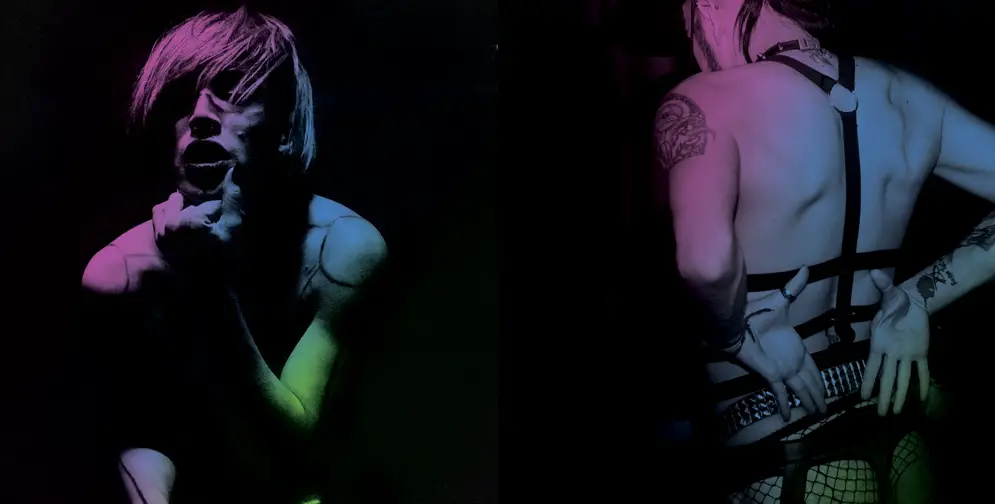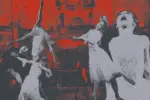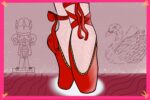The art and dance collective known as the House of Kenzo is made up of six members: Breeann Ashley, Bobby Britton, Roxy Eguia, Antonio Padron, Karma Stylz and Gemel Williams.
Several of the Kenzo kids knew each other before the group existed, as Britton, Eguia and Williams went to the same high school, and Ashley and Stylz had been friends since childhood. But it wasn’t until 2012, when Eguia and Padron collaborated on several projects, that the House of Kenzo really began to take shape.
Under the name Rainbow Starchild (“RNBWSTRCHLD”), Eguia designed the costumes for some of Padron’s dance performances, while Padron choreographed some of Eguia’s runway shows, one of which included several future members of the House of Kenzo.
“One of the showcases Antonio and Karma choreographed, was for a Milky Way collection we did,” says Eguia. “It was 10 looks — all of the planets including the sun — and each look was inspired by the elements of each planet. That’s how we really started working with one another.”
After that the members of the House of Kenzo were practically inseparable, practicing several days a week from six to nine in the morning, going to events together and slowly assembling the collective that they’ve become known for.
Eguia recalls a moment in 2014 when she and the other Kenzo kids went to the Stargayzer Festival in Austin, Texas, and outdanced everybody during a set from the prominent ballroom figure MikeQ.
“We were all in rainbow garb and just jumped onstage and started dancing,” Eguia says. “Then somebody battled us, and somebody else battled us. Everybody was like, ‘Who the fuck are you guys?’ Shortly after that we came up with the name the House of Kenzo.”
A bit of ballroom and vogue history for context: Voguing is a form of dance born from the Harlem ballroom scene of the 1980s. Although still a largely underground community across the country, vogue culture rose to prominence in the early ‘90s thanks to Madonna’s hit single “Vogue” and the documentary “Paris Is Burning.” Where the former commoditized the culture and brought it to the masses, the latter explored the intricacies of it — the glamor, violence, lifestyle and art.
As with most traditional “houses,” there is a hierarchy. A “house mother” or “house father” have “children,” and the children have to adhere to the rules set up by their house parent.
Houses are named after fashion designers, and members of the houses often participate in events called “balls.”
Although the House of Kenzo is inspired by ballroom and vogue culture, all of the members are adamant about not being referred to as a “vogue house.”
“We do more than just dance to vogue music,” says Ashley. “We know African, modern, contact improvisation, breaking, hip hop, pole dancing and much more. Not only that, but our performances include installations and plot settings — we are an art collective.”
Williams adds: “Although we do channel vogue dancing, our goal is to expand upon what being a house means in today’s day and age, and how we can push the idea to be more relevant to this modern, digital age.”
Trying to gauge what exactly the House of Kenzo embodies while it’s still a relatively young project is difficult to do. But the more the group hosts and participates in events throughout Texas, the more solid their identity becomes.
Last year the collective participated in several events in San Antonio, in addition to hosting a ball over the 4th of July holiday weekend. Unfortunately, the event ended up being raided by the San Antonio Police Department because of a misunderstanding.
“The San Antonio Police Department mistook our venue for K23 Gallery,” Eguia says, “and pulled up with at least eight squad cars and a total of three paddy wagons prepared to arrest as many people as possible. The vice squad arrested four people that night including myself.”
Regardless of the raid, the night was still considered a success. The House of Kenzo called the event San Antonio’s “first ball ever.”
Following that, the group performed alongside Lex Luger and Uniiqu3 at Austin’s Vulcan Gas Company venue in August, and were also a part of the fifth anniversary of GAYCL (an annual showcasing LGBTQ performers) in October. The collective ended the year by attending Art Basel in Miami, where they put on several secret shows.
Inevitably, the House of Kenzo’s growing exposure has led to some worthwhile opportunities both for individual members and the collective. Ashley will be serving as a choreographer for New York rapper Dai Burger’s forthcoming 2016 tour, and the House of Kenzo will be making their South By Southwest debut this year.
Their Southby showcase, hosted by Austin-based record label #FEELINGS, will feature the group dancing alongside label artists Ben Aqua, Creepside, Supraman and Ynfynyt Scroll, as well as performing a routine of their own.
“We’re exploring the parallels between plant growth and personal growth with this performance,” Eguia says. “It’s going to be an interactive installation, where we begin on our knees in soil and over a period of time we grow toward our light. We’re also going to invite attendees to douse us in dirt and water.”
The show serves as a reflection of the House of Kenzo’s gradual growth and the uncertainty the collective faces about the future. Eguia also refers to the performance as a rebirth, as she talks about certain setbacks she and the rest of Kenzo have endured during the group’s formation.
“The South By Southwest performance is important to us, because we’ve had to trim the fat from the House of Kenzo,” Eguia says. “The team has grown so much and we’re beginning to realize our own roles and responsibilities within the group, which is why we’ve chosen to do this presentation.”
What will become of the House of Kenzo after their South By Southwest debut is unknown, but all of the members don’t seem worried about it. “This is only the beginning of the Kenzo takeover,” Britton says.
“I see Kenzo breaking down every wall in the ballroom scene and focusing more on our own individual contributions to the universe. We want to showcase why we should all love fearlessly, love wholeheartedly and communicate more through movement of the body.”

















